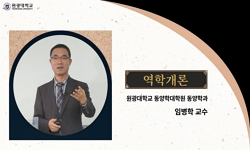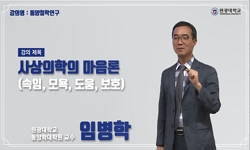Tripitaka Koreana was made by companng many versiOns, and thus, it is the most accurate and perfect Tripitaka among the numerous Tripitaka translated into Chinese. However, Chinese characters were used in making the Tripitaka Koreana because it was ma...
http://chineseinput.net/에서 pinyin(병음)방식으로 중국어를 변환할 수 있습니다.
변환된 중국어를 복사하여 사용하시면 됩니다.
- 中文 을 입력하시려면 zhongwen을 입력하시고 space를누르시면됩니다.
- 北京 을 입력하시려면 beijing을 입력하시고 space를 누르시면 됩니다.
https://www.riss.kr/link?id=A99542153
- 저자
- 발행기관
- 학술지명
- 권호사항
-
발행연도
2002
-
작성언어
Korean
- 주제어
-
등재정보
KCI등재
-
자료형태
학술저널
-
수록면
171-192(22쪽)
- 제공처
- 소장기관
-
0
상세조회 -
0
다운로드
부가정보
다국어 초록 (Multilingual Abstract)
Tripitaka Koreana was made by companng many versiOns, and thus, it is the most accurate and perfect Tripitaka among the numerous Tripitaka translated into Chinese. However, Chinese characters were used in making the Tripitaka Koreana because it was made before Hangul was invented. Therefore, it was not easy for the gerenal public to read these Scriptures. These Buddhist Scriptures began to be translated after King Sejong created Hangul. In the 15th Century, during Sejong's reign, Wolinchungangjigok(월인천강지곡) and Suckbosangjul (석보상절) were written in Hangul, and during Sejo' s reign (1461, Sejo 7) Kankyungdogam (간경도감) was established and Buddhist Scriptures were translated and published in Hangul for the first time. However, Kankyungdogam lasted only 10 years before it was closed. After the Chosun period, the Scriptures were translated by many temples and individuals, but these were translations of only parts of the Tripitaka. After the purification campaign came to an end, the Jogye Order of Korean Buddhism selected apprenticeship training, propagating, and Sutra translation as the 3 main projects of the Order. The Sutra Translation Committee Law was legislated to place the Committee under the direct control of the Order, and in 1963 and 1964, 38 people were commissioned by Rev. Hyobong, who was the head of the Order at that time, to be members of the committee. Also, an agreement was reached to found the Dongguk Sutra Translation Center within Dongkuk University in order to promote cooperation between the General Affairs Department and Dongguk University and carry the translation project forward. On July 21, 1963, the Dongguk Sutra Translation Center held an opening ceremony and was formally launched. Their efforts bore fruit on June 30, 1965, when the first book of the Hangul Tripitaka, Dirghagama, was published. For 5 years from 1966 to 1970, a government subsidy allowed 8 volumes of Hangul Tripitaka to be published each year, and by 1973, a total of 67 volumes were published. In 1975, the 48 volumes of the facsimile edition of Tripitaka Koreana were completed. After Rev. Un-huh, who was the first director of the Center, became an honorary director in 1979, the Sutra translation project was not very productive, but after Rev. Wol-un became the new director in 1993, the project became more active. The Center was awarded a subsidy of 1.3 billion won from the government for the next 4 years and the Hangul Tripitaka project gained propulsive force. The subsidy was extended for 2 years and the Tripitaka Koreana translation project that had continued for 36 years was finally cmnpleted in 2000 with the publication of 318 volumes. Since 2001, the Center has been supported by the government in a 10 year project for revising and supplementing the Hangul Tripitaka. In addition, in cooperation with the Electronic Buddhist Text Institute in Dongguk University, the Center is working to create an electronic version of the Tripitaka. The Center also plans to review and examine the imperfections of the Hangul Tripitaka such as inaccurate translation and take complementary measures to improve it.
목차 (Table of Contents)
- I. 불전의 국역
- II. 한글 대장경이 완간되기까지
- III. 한글대장경의 개역과 전산화 사업
- ABSTRACT
- ‘동국역경원의 역경 사업’에 대한 논평
- I. 불전의 국역
- II. 한글 대장경이 완간되기까지
- III. 한글대장경의 개역과 전산화 사업
- ABSTRACT
- ‘동국역경원의 역경 사업’에 대한 논평
동일학술지(권/호) 다른 논문
-
朝鮮 初期의 譯經 - 最初의 譯經『釋譜詳節』을 중심으로 -
- 대각사상연구원
- 김영배
- 2002
- KCI등재
-
- 대각사상연구원
- 김순석
- 2002
- KCI등재
-
- 대각사상연구원
- 한보광
- 2002
- KCI등재
-
- 대각사상연구원
- 윤창화
- 2002
- KCI등재





 eArticle
eArticle







